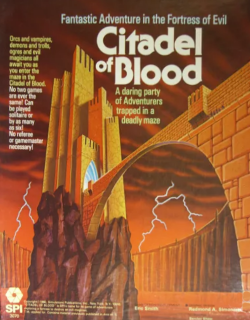
Citadel of Blood, subtitled "Fantastic Adventure in the Fortress of Evil". is a dungeon-crawl board game published by Simulations Publications, Inc. (SPI) in 1980.

Citadel of Blood, subtitled "Fantastic Adventure in the Fortress of Evil". is a dungeon-crawl board game published by Simulations Publications, Inc. (SPI) in 1980.
Citadel of Blood is a cooperative fantasy dungeon crawl where 1–6 players enter the dungeon of the evil wizard "X the Unknown", kill any monsters encountered and take their treasure. Unlike fantasy role-playing games with a dungeon-crawl theme such as Dungeons & Dragons , Citadel of Blood does not need a gamemaster to design the dungeon and play the monsters within during combat, nor does it use numbered paragraphs as were used in Flying Buffalo's Buffalo Castle expansion for Tunnels & Trolls . Rather, the players randomly draw tiles representing rooms and corridors one at a time as they progress, slowly building up the dungeon tile by tile. [1]
This game is based on SPI's previous publication Deathmaze , but with the addition of character races, dungeon levels and different "colors" of magic depending upon phases of the moon.
SPI published Deathmaze in January 1980, a dungeon-crawl board game designed by Greg Costikyan and Redmond A. Simonsen. Eric Smith then modified the game, adding variations of races and magic. The result, Citadel of Blood, was published as a pullout game in Ares Magazine #5 (November 1980), then released as a boxed set. [1]
Keith Gross reviewed Citadel of Blood in The Space Gamer No. 37. [2] Gross commented that "Citadel of Blood is recommended to fans of Deathmaze and to fantasy gamers who want something to play when they don't have the time for a bigger game." [2]
In Issue 54 of Moves (December–January 1981), Jules Leites commented that the redesign of Citadel of Blood lifted it above Deathmaze, making it "much more nearly state of the art than its simpler predecessor, and it is capable of challenging even the most advanced [fantasy role-playing] gamers." He also pointed out that SPI's previously published Swords & Sorcery boardgame (1978) had separate "Army" and a "Quest" games, and suggested a set of rule variants for Citadel of Blood to allow it to be used as a link between those two parts. [3] .

RuneQuest is a fantasy tabletop role-playing game originally designed by Steve Perrin, Ray Turney, Steve Henderson, and Warren James, and set in Greg Stafford's mythical world of Glorantha. It was first published in 1978 by The Chaosium. Beginning in 1984, its publication passed between a number of companies; Avalon Hill, Mongoose Publishing, The Design Mechanism, finally returning to Chaosium in 2016. RuneQuest is notable for its system, designed around percentile dice and with an early implementation of skill rules, which became the basis of numerous other games. There have been several editions of the game.
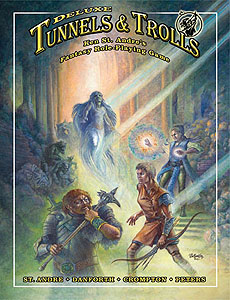
Tunnels & Trolls is a fantasy role-playing game designed by Ken St. Andre and first published in 1975 by Flying Buffalo. The second modern role-playing game published, it was written by Ken St. Andre to be a more accessible alternative to Dungeons & Dragons and is suitable for solitaire, group, and play-by-mail gameplay.

Games Workshop Group is a British manufacturer of miniature wargames, based in Nottingham, England. Its best-known products are Warhammer Age of Sigmar and Warhammer 40,000. It is listed on the London Stock Exchange and is a constituent of the FTSE 250 Index.
Simulations Publications, Inc. (SPI) was an American publisher of board wargames and related magazines, particularly its flagship Strategy & Tactics, in the 1970s and early 1980s. It produced an enormous number of games and introduced innovative practices, changing the course of the wargaming hobby in its bid to take control of the hobby away from then-dominant Avalon Hill. SPI ran out of cash in early 1982 when TSR called in a loan secured by SPI's assets. TSR began selling SPI's inventory in 1982, but later acquired the company's trademarks and copyrights in 1983 and continued a form of the operation until 1987.
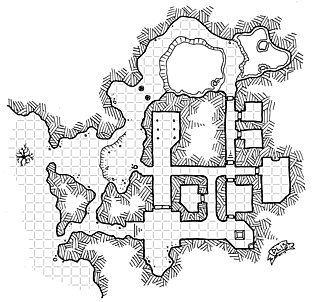
A dungeon crawl is a type of scenario in fantasy role-playing games in which heroes navigate a labyrinth environment, battling various monsters, avoiding traps, solving puzzles, and looting any treasure they may find. Video games which predominantly feature dungeon crawl elements are considered to be a genre.

HeroQuest, sometimes written as Hero Quest, is an adventure board game created by Milton Bradley in conjunction with the British company Games Workshop. The game was loosely based around archetypes of fantasy role-playing games: the game itself was actually a game system, allowing the gamemaster to create dungeons of their own design using the provided game board, tiles, furnishings and figures. The game manual describes Morcar/Zargon as a former apprentice of Mentor, and the parchment text is read aloud from Mentor's perspective. Several expansions were released, each adding new tiles, traps, artifacts, and monsters to the core system.

Greg Costikyan, sometimes known under the pseudonym "Designer X", is an American game designer and science fiction writer. Costikyan's career spans nearly all extant genres of gaming, including: hex-based wargames, role-playing games, boardgames, card games, computer games, online games and mobile games. Several of his games have won Origins Awards. He co-founded Manifesto Games, now out of business, with Johnny Wilson in 2005.

Violence: The Role-Playing Game of Egregious and Repulsive Bloodshed is a short, 32-page role-playing game written by Greg Costikyan under the pseudonym "Designer X" and was published by Hogshead Publishing in 1999 as part of its New Style line of games.

Steve Jackson is an American game designer. His notable creations include the role-playing game GURPS and the card game Munchkin.
Warhammer Quest is a fantasy dungeon, role-playing adventure board game released by Games Workshop in 1995 as the successor to HeroQuest and Advanced HeroQuest, set in its fictional Warhammer Fantasy world. The game focuses upon a group of warriors who join together to earn their fame and fortune in the darkest depths of the Old World.

Flying Buffalo Inc. (FBI) is a Scottsdale, Arizona game company that publishes role playing games, card games, gaming materials, and runs play-by-mail games.

Ares was an American science fiction wargame magazine published by Simulations Publications, Inc. (SPI), and then TSR, Inc., between 1980 and 1984. In addition to the articles, each issue contained a wargame, complete with a foldout stiff paper map, a set of cardboard counters, and the rules.
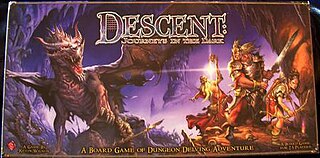
Descent: Journeys in the Dark is a two to five player high fantasy dungeon crawl published by Fantasy Flight Games in 2005. Descent was designed and produced by Kevin Wilson. The game is based on an improved version of the mechanics of FFG's licensed Doom: The Boardgame. In Descent, players take the roles of adventurers who delve into underground complexes in search of treasure. One player takes the role of the Overlord, who controls the enemies and plays cards to hinder the hero players. Descent differs from other games in the genre in that the Overlord player's goal is to win by exhausting the other players of victory points, rather than merely to facilitate play. The Overlord's resources are limited by the rules of the game, which require them to hoard and expend "threat" points, which are generated in response to the hero players' actions, in order to hamper the other players and to bring out additional monsters to defeat them. This mechanism is very much reminiscent of The Lord of the Rings when playing with the Sauron optional expansion.
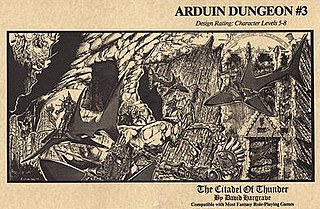
The Citadel of Thunder was a standalone short story and gaming module written in 1979 by David A. Hargrave and published by Grimoire Games. It was based upon Hargrave's gaming system known as Arduin. It is the third of only four standalone "dungeon" books created by Hargrave as an extension of his Arduin Multiverse, which at the time of The Howling Tower's publication was known as The Arduin Trilogy.
Deathmaze is a board game published by Simulations Publications in January 1980, and designed by Greg Costikyan and Redmond A. Simonsen. It falls into the general category of dungeon crawls, more specifically, dungeon games in which players enter a dungeon, massacre the dungeon dwellers and steal their treasures.
Eric Goldberg is an American game designer who has worked primarily on role-playing games.
Monsters in the Dungeons & Dragons fantasy role-playing game are generally the antagonists which players must fight and defeat to progress in the game. Since the game's first edition in 1974, a bestiary was included along other game manuals, first called Monsters & Treasure and now commonly called the Monster Manual. Described as an "essential" part of Dungeons & Dragons, the game's monsters have become notable in their own right, influencing fields such as video games and fiction, as well as popular culture.
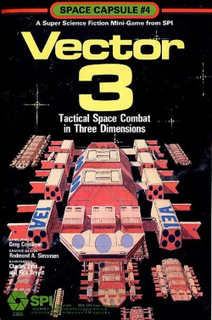
Vector 3 is a science fiction combat microgame published by Simulations Publications, Inc. (SPI) in 1979.

Heroic Fantasy is a dungeon crawl play-by-mail game published by Flying Buffalo. It has been active since 1982. The initial edition involved nine dungeon levels. Flying Buffalo published subsequent editions due to challenging gameplay initially, eventually limiting the game to four dungeon levels with a fifth "outside" level where players can assemble an army and capture one or more castles. The game is open-ended; gameplay continues until players decide to stop.

Labyrinthine is a fantasy board game published by Wee Warriors in 1977. Based on themes taken from the then-newly published Dungeons & Dragons, Labyrinthine was the first "dungeon crawler" board game to use a totally modular board that was reconfigured for each game.